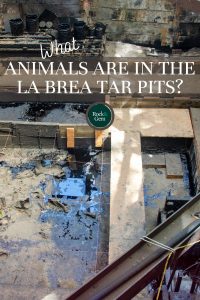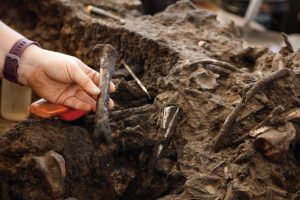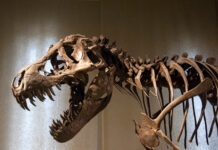
The La Brea Tar Pits site is the largest collection of late Pleistocene asphaltic fossils in the world and it’s located in an unlikely place, Los Angeles, the second largest city in the United States and the land of palm trees, movie stars, Malibu and the Hollywood Walk of Fame.

Located right in the middle of downtown L.A., among the freeways and skyscrapers, the La Brea Tar Pits is an active paleontological research site where scientists dig for dinosaurs. The site is formed around a group of tar pits, where natural asphalt has been seeping up through the ground for tens of thousands of years. Over millennia, Ice Age animals became trapped in the sticky asphalt, which then preserved their bones as fossils. Trace fossils don’t come into play as much here as the actual bones themselves.
Finding the La Brea Tar Pits
The Tar Pits were first observed by European explorers in 1769, but were known to the Native peoples of Southern California for generations. The presence of fossils in the bubbling asphalt was not discovered until 1901 by a Union Oil geologist. When the significance of the pits was realized after years of fruitful excavation of fossils, the property’s owner, George Allan Hancock, donated the land to the County of Los Angeles so it could be preserved. Excavation of the pits continued on and off through the early 20th century, and in 1977, the George C. Page Museum, which housed many of the pit fossils, was opened to the public. To date, millions of fossils are on display at the museum, which is now called the Page Museum and Tar Pits. Visitors can watch paleontologists work in the lab and get an up-close look at the research being performed.

Deadly Tar
The reason behind the rich trove of Pleistocene fossils found at the La Brea Tar Pits lies in the unusual geology of the site. A large reservoir of petroleum called the Salt Lake Oil Field is located beneath the surface of the land; the result of marine plankton deposited in an ocean basin during the Miocene Epoch of five to 25 million years ago. During that time, the tectonic plates in the Southern California region changed to strike-slip faults, and crustal plates rotated. This stretched the Los Angeles region and formed a deep structural basis. Large amounts of marine sediments were deposited and were six feet deep in sections. Later, nearby mountains uplifted, and rivers flowing down brought large amounts of sand and gravel with them.
During the last 50,000 years, this petroleum—actually a low-grade crude oil and not tar, despite the site’s name, trapped and preserved the remains of animals and plants that lived in the area, which were then buried by sediment. The preservative properties of asphalt have maintained the integrity of bones that would have perished in other environments.
Tar Pit Discoveries
Discoveries from the La Brea Tar Pits have revealed a huge variety of animals that became stuck in the asphalt when it was covered over by water, dust or leaves. Mistaking the pits for a pond or solid ground, animals stepped onto it and became trapped. Carnivores were drawn to the trapped animals and became stuck themselves. Insects and birds became caught in the sticky substance as well, and over thousands of years, millions of creatures had fallen victim to the pits.
These circumstances, which played out long before Los Angeles existed as a city, have made the La Brea Tar Pits one of the most significant paleontological sites in North America.
“Our site has literally millions of specimens,” says Emily Lindsey, Ph.D., Associate Curator, and Excavation Site Director. “In some cases, we have thousands of individuals represented. This allows scientists to ask questions about species biology, behavior, and evolution that are almost never possible to study in the fossil record.”
A Unique Site
The Tar Pits are also unique because they have provided a variety of fossils that are rarely found together, including plants and animals, big fossils and small fossils, with more than 500 species in total, making it one of the only fossil sites in the world where something approximating an entire ecosystem is represented, according to Dr. Lindsey.
In addition, she points out that the period that La Brea Tar Pits covers is incredibly important for understanding the place we are in today.
“Over the last approximately 50,000 years, glaciers advanced and receded; the Ice Age ended; humans arrived for the first time in North America; and nearly three-quarters of all large mammals on Earth went extinct,” she says. “Studying how all these different processes interacted can give us valuable information for addressing today’s challenges of climate change, human impacts on ecosystems, and extinctions.”

Many Species of the La Brea Tar Pits
The sheer variety of animal fossils that have been uncovered in the pits is unprecedented and spans from herbivores like wooly mammoths and ground sloths to predators such as dire wolves and saber-toothed cats. Birds like eagles and vultures and insects such as beetles and flies have been found, along with freshwater invertebrates such as mollusks and anthropoids, that may have found their way into the pits because of streams flowing into the area.
The large animal most often discovered in the pits is the dire wolf (Aenocyon dirus), with nearly 4,000 individual wolves having been excavated from the pits. The Tar Pits boast the largest number of dire wolf fossils ever found, and more than 400 of their skulls are on display at the Page Museum. Dire wolves were larger than modern wolves, and preyed on western horses (Equus occidentalis), ancient bison (Bison antiquus), ancient ground sloths (Xenarthra), and camels (Camelops), all species found in the La Brea fossil record. Dire wolves were likely lured into the pits by the herbivore species they preyed on that had become trapped in the asphalt.
Other Common Finds
The second most common large animal found in the Tar Pits is the saber-toothed cat (Smilodon fatalis). The Page Museum houses the largest collection of sabertoothed cat fossils in the world, with 2,000 individual animals discovered in the pits. This well-known ancient predator could weigh as much as 600 pounds and possessed two dagger-liked front teeth designed for killing. Saber-toothed cats preyed frequently on two of the herbivore species commonly found in the La Brea Tar Pits: bison and camels. This likely explains why so many of these predators were found in the pits.
In addition to western horses, ancient bison, ground sloths, and camels, other herbivores fell victim to the sticky asphalt, leaving their bones behind. Wooly mammoths, mastodons, elephants, and tapirs have all been found at the site, along with modern species like coyotes, raccoons, and rabbits.
Providing Information
Although large animals found at the La Brea Tar Pits get the most attention, a variety of other tinier fossils excavated from the pits is providing a wealth of information to paleontologists studying the behavior of ancient species, as well as the process of extinction.
“Fossils from La Brea Tar Pits have given unprecedented insight on what the world looked like during the Pleistocene or Ice Age,” says Dr. Lindsey. “Thanks to this treasure trove of fossils, scientists have concluded that saber-toothed cats hunted in groups; that bison migrated in and out of the Los Angeles area; and that trees were starved for carbon during the height of the Ice Age.”
But according to Dr. Lindsey, the most powerful findings of the Tar Pits are likely yet to come.
“A renewed focus on smaller fossils— such as leaves, seeds, insects, rodents, lizards, and birds—has the power to tell us a lot about how climate change and human activities intersected to turn the lush megafauna savannah of the Ice Age into the Southern California landscape we know today.”
La Brea Tar Pits: Project 23In 2005, construction workers were building a new parking garage for the Los Angeles Museum of Art, located next to the La Brea Tar Pits. During the digging, they unearthed an incredible find: a previously undiscovered asphalt pit containing 16 fossil deposits. A total of 23 wooden boxes of fossils were taken from the construction site. To date, scientists have found millions of fossils in these deposits, and have so far identified a sabertoothed cat, dire wolves, bison, horses, a giant ground sloth, turtles, snails, clams, millipedes, fish, gophers, an American lion, and a nearly intact Columbian mammoth skeleton, including the skull and 10-foot-long tusks. The mammoth, nicknamed Zed, is the first nearly complete individual mammoth to be found near the Tar Pits. Labeled Project 23, paleontologists are currently working at the Page Museum lab to separate and identify all the various fossils found in these 16 deposits. The bones from different animals are usually jumbled together, and researchers lay them out on a grid on top of the deposit so they can record where each bone came from. A datum point is established to measure the depth of the fossils, and tools are selected to do the work based on the kind of dirt surrounding the fossils. For hard areas that lack fossils, hammers and chisels are used. When working near fossils, scientists use dental picks. Visitors to the Page Museum and the La Brea Tar Pits can watch this process, seeing scientists work on the contents of the 23 boxes in real time. |
This story about the La Brea tar pits previously appeared in Rock & Gem magazine. Click here to subscribe. Story by Audrey Pavia.















